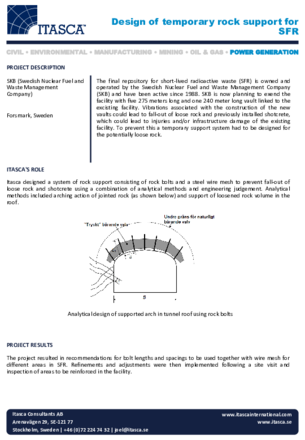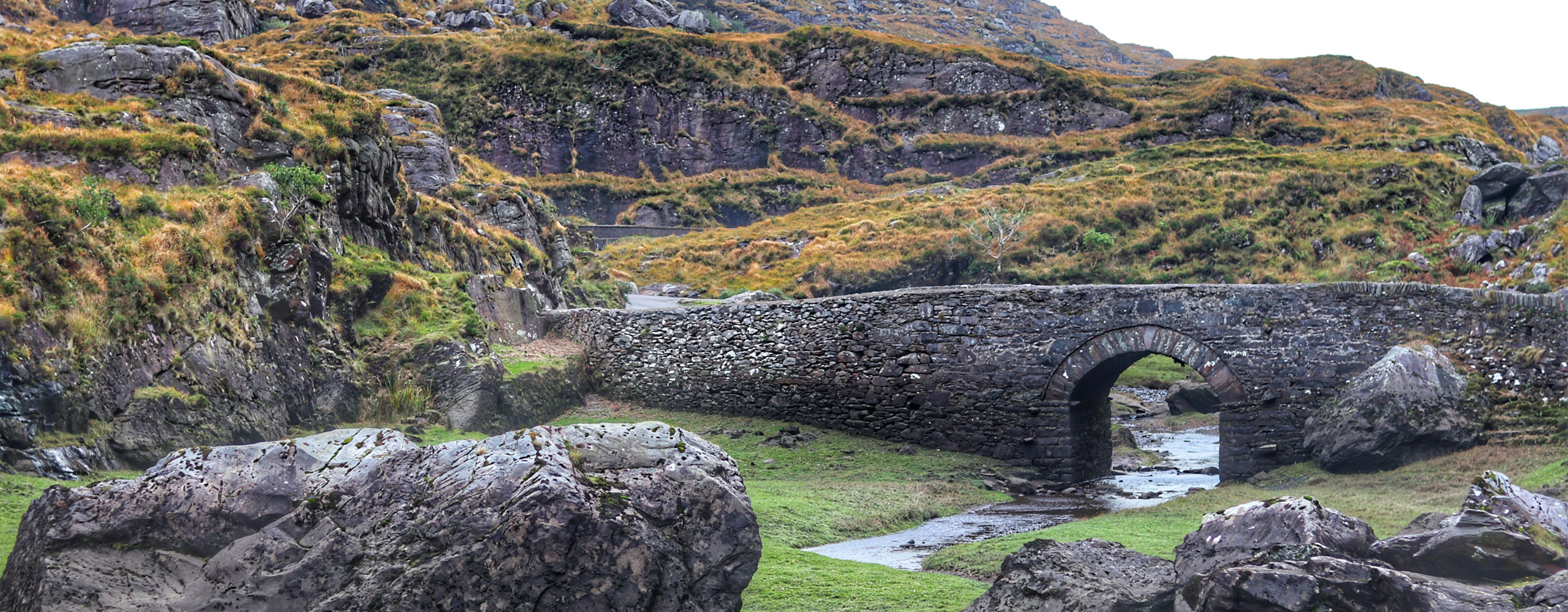
Design of temporary rock support for SFR (2021)
The Swedish Nuclear Fuel and Waste Management Company (SKB) is planning to extend the short-lived radioactive waste repository with five 275 meters long and one 240 meter long vault. Since the extension could lead to damage on the existing facility, Itasca designed a temporary support system to prevent loose rock.

Rock mechanical analyses for the Boliden deep repository at Rönnskär (2020)
Boliden AB is constructing an underground repository for final storage of process waste material from the Rönnskär copper smelter facility. The repository is excavated at a depth of 330 m and the main components are storage rooms with a vertical footprint of 16 by 18 m and with lengths varying between 50 and about 200 m. Itasca was contracted by Boliden to carry out rock mechanical analysis to assess the stability in both the short- and long-term (3000 years) perspectives. FLAC3D and 3DEC models were used to study global and local stability as well as the potential for long term effects on flow paths in the rock mass resulting from the excavation of the repository.

Practical Open Pit Rock Mechanics (2017)
Open pit mining often result in high rock slopes, sometimes combined with difficult rock conditions. This is further augmented by large blasting rounds resulting in high vibrations. Reinforcement of pit slope walls is also difficult and many times associated with high costs and loss of production. Bench slope stability is vital for a safe working place for all personnel in the mine as well as for avoiding production loss. Itasca Consultants AB is providing technical, on-site rock mechanics expertise to several open pit mines in northern Sweden.

Sjömalmen — Cave Modeling and Prediction of Ground Deformations (2017)
The city of Kiruna is partly located on the hanging wall side of the LKAB Kiirunavaara Mine. In the long-term perspective, it is not possible to have any residential buildings or infrastructure within the fracture zone and cave zone resulting from mining. An urban transformation process for the Kiruna city center is thus currently underway. The current prognosis is empirical based on observations since the early 1960s until today.

Rock Mechanics Pre-Feasibility Studies (2017)
When starting a new mine, whether it's a open pit or an underground mine, the designer faces many challenges! One of these is the understanding of rock mass conditions and how this affects the choice of mining methods and the mine design at an early stage.

Back-Analysis of Initial Stress at Shallow Depth – A Case Study (2016)
At shallow depth, the initial stress state can significantly affect the behavior of the rock mass around excavations, but stress measurements are usually subjected to high levels of uncertainty. This was the case at the Odenplan railway station in Stockholm where unexpectedly large deformations were measured during the excavation.

Regional-Scale Stress Model of the Stockholm Area (2016)
New metro lines are planned in Stockholm, comprising a total length of approximately 20 km with 10 new stations, mostly located underground. One of the new lines will pass under Saltsjön (a bay of the Baltic Sea) and through a major regional large-scale geological structure. The stress magnitudes and orientations around the structure are highly uncertain, and stress measurements are not practically possible near the structure. To quantify possible stress conditions near the structure, discontinuum threedimensional numerical modeling was conducted.

Bench Stability Analysis at Björkdalsgruvan (2016)
The Björkdal mine ("Björkdalsgruvan"), located 28 km northwest of the town of Skellefteå, is a gold mine with the mineralization typified by Au-quartz veins located within a metamorphic package. The Björkdal mine is operating with both open pit- and underground mining. During spring 2016 the mine experienced local slope instability at one of the open pit walls. The concern was how it would affect safety for the mine workers and future mining, but also if it was safe to remove loose rock mass without endangering workers or interrupt any mining activities.

Definition and flow analysis of UFM model for the Forsmark site (2016)
The Forsmark site is studied in the context of the Swedish nuclear disposal project. One key step is defining, at the relevant depths ‐ from 200 to 400m ‐ a Discrete Fracture Network (DFN) model. The DFN modeling framework is based on simplified rules that mimic the kinematic processes governing fracture nucleation, growth and arrest (models are named UFM for likely Universal Fracture Model).

Tunneling in Mixed Face Conditions (2015)
A research project on tunneling in mixed face conditions (rock-soil) was carried out with the aim to increase the knowledge and to better understand deformation mechanisms when these particular conditions arise. A back analysis of a case study involving the tunnel passage under the Maria Magdalena church was performed as a second task of the project, in which soil stratigraphy, rock/soil reinforcement, and extraction sequence were simulated explicitly and in detail.

Estimation of Fracture Shear Displacements due to Slot Excavation (2015)
The main objective of the project was the estimation, via numerical modelling, of the displacement induced in fractures by the excavation of destressing slots at the Äspö Hard Rock Laboratory.

SKB Apsö UFM application (2015)
SKB asked ITASCA to apply an advanced modelling framework (UFM) on the Äspö site to estimate its consistency with structural and hydraulic data. The UFM modelling framework (detailed in Davy et al., (2010, 2013)) is used to assess fracturing parameters and improve the DFN models in Äspö using in‐depth data.

Ore Pass Design - A Modeling Study (2015)
The LKAB mining company is currently carrying out investigations for a potential continued mining at depth in the Malmberget mine. Part of this work involves design of ore passes. The ore passes are a vital part of the transportation chain, and has, historically, been subject to extensive instabilities leading to closing and re-development of ore passes.

Guidelines on Design of Rock Excavations (2015)
In 2009, the Swedish National Rail Administration presented a handbook with guidelines for the design of the load-bearing structure of rock tunnels. Following the merging of several transport administrations into The Swedish Transport Administration, an updated version of the handbook was required.

3D-Analysis of the Stockholm By-Pass Road Tunnel (2014)
A new motorway west of Stockholm linking the north and south side of Stockholm is under development – the so-called "Stockholm By-Pass" ("Förbifart Stockholm"). The new link is a 21 km long highway, of which 18 km is in tunnels. At the interchange of Lovön, four intake and exhaust air stations are planned, being in close proximity to the main tunnels and ramps. In this area, there is also a deformation zone going through the intake and exhaust air station.
